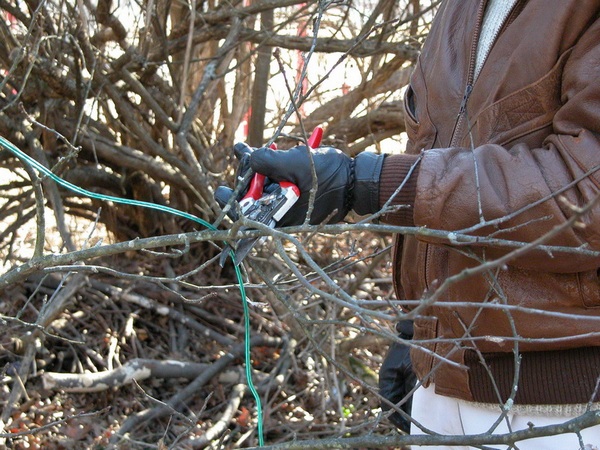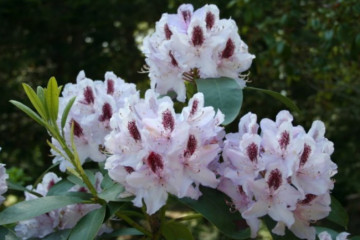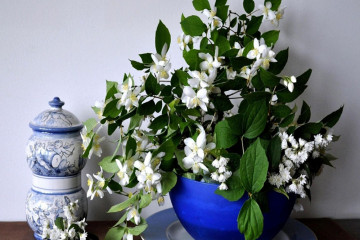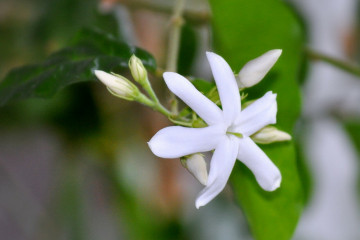Why garden or indoor jasmine does not bloom and what to do
Content:
Jasmine is a spectacular ornamental shrub that blooms lush and abundantly. There are many varieties of culture, and terry inflorescences look especially impressive. However, violations of the rules of plant care, diseases or pest attacks lead to various problems. In such a situation, many people wonder why jasmine does not bloom.
What year does jasmine bloom and how long does the flowering period last?
Jasmine, or chubushnik, is highly decorative - it is grown at home or in the garden. Most often, the plant has beautiful white flowers. Due to this, it is often used in landscape design.
Many people are interested in what year after planting jasmine blooms. The timing of the beginning of flowering directly depends on the variety. This usually occurs at 2-4 years of age.
At the same time, there are no guarantees at all that the culture will bloom at this age. Growing conditions may not be suitable for the crop, causing the buds to fall off. In such a situation, it is necessary to take care of the jasmine bush so that it can bloom.
The flowering period depends on the type of shrub:
- spring - bloom from early spring to late summer;
- summer - flowers appear from June and persist until the first frost;
- winter - bloom from the beginning of the year to mid-spring.
The region of cultivation is also important. So, in the Moscow region, flowers will appear earlier than in Siberia, but later than in the southern regions. When planting, you need to know how many years the jasmine begins to bloom.
Differences in flowering garden and indoor jasmine
The main feature of a houseplant is the presence of a period of winter dormancy. Flowering can last from early spring to autumn. When grown at home, flowers are present for 3 weeks. Then they fall off, and the bush forms new shoots.
Reasons for the lack of flowering in garden and indoor jasmine
There are many factors that lead to the disruption of cultural development. So why doesn't garden jasmine bloom? Experienced owners point to a number of reasons, which will be discussed below.
Moisture stagnation or lack of moisture
If the flower is planted in an area with a high groundwater table, there is a risk of liquid stagnation. In this case, a violation of the development of the root system occurs, which provokes its decay.
Insufficient soil moisture also becomes a provoking factor of problems. Jasmine needs systematic watering. In winter, it should be reduced to 2 times a week.
Insufficiently acidic soil
The flowering of a crop directly depends on the parameters of the acidity of the soil.In neutral or alkaline soil, foliage build-up is observed. At the same time, there is a risk of problems with flowering.
For the full formation of buds, jasmine requires acidic soil. You can buy it at a flower shop or make it yourself. In the second case, it is worth taking turf, leafy soil and sand in a ratio of 3: 1: 1.
Mix the ingredients well, moisten and place a drainage layer in the pot. The bush should be planted shallow - the root collar should only be lightly covered with earth.
Diseases and pests
With proper care, the culture has strong immunity and does not face dangerous diseases. However, she is able to suffer from pest attacks.
Most often, jasmine is attacked by whiteflies and spider mites. There is also a risk of attacks by aphids and weevils.
In simple cases, it is enough to treat the shrub with soapy water. In advanced situations, insecticidal preparations have to be used:
- Actellik,
- Intavir,
- Agravertine.
Errors when applying top dressing
The lack of flowering may be due to improper fertilization. The culture should be fed with a small amount of organic matter. This is done when landing. Subsequently, it is worth making special compositions or products for flowering plants.
Top dressing should be applied every 10 days during the growing season. However, you need to know that an excess of fertilizers provokes thickening and uncontrolled development of green mass. This negatively affects the flowering of the culture.
Inappropriate lighting
A blooming culture needs sufficient light, but does not tolerate the influence of direct sunlight. If the bush is exposed to the scorching sun, the unopened buds crumble.
Temperature changes
Sudden changes in temperature parameters within a short period of time and exposure to drafts can cause crop death.
- The best option for jasmine is the range of +18 .. + 25 degrees.
- In winter, the pot with the plant should be moved to a room with a temperature of +8 .. + 10 degrees. This provides abundant bloom in spring.
No clipping
Pruning is considered an important activity to ensure uniform and timely flowering. If you neglect this procedure, there is a risk of problems.
First of all, you need to remove dry fragments of the bush, and then cut off the naked and long branches.
Plant age
If the plant is too young, do not expect to start flowering quickly. After planting, you must wait at least 2 years. The owner of the plant definitely needs to know the varietal characteristics so as not to wait for flowering in vain.
Other Potential Flowering Problems
There is a risk of other problems when growing jasmine. So, the formed buds can crumble. In addition, there is a threat of the appearance of too small inflorescences.
Sprinkling buds
The following factors can lead to bud fall:
- too bright sun;
- damage to the bush by parasites;
- violation of the temperature regime;
- development of diseases.
Small flowers
Sometimes a situation arises when the buds are formed, but are too small in size. Most often this is due to insufficient soil fertilization. Planting jasmine in a shady place can also be a provoking factor.
What to do if jasmine does not bloom on the site or at home
If indoor jasmine does not bloom, what to do in this case? It is important to establish a plant care regimen.The culture needs systematic watering, timely weeding of the soil, and loosening. If you plan to grow a plant in the country, it should be planted in a sunny place with a little partial shade. It is important to choose an area without excess moisture.
To achieve lush flowering, you should pay attention to the following features of growing a crop:
- Fertilizer. Mineral products must be applied 2 times during the growing season. For the first time, this should be done in the spring - in March or April. For the second time, jasmine is fed in the fall - from the last week of August to October. At the stage of rapid development of the shrub, it is worth using nitrogen substances. When flower buds open, the plant needs potassium. Throughout the summer, products with the addition of phosphorus are used.
- Pruning. At the end of June, jasmine must be pruned. In this case, thickened branches are removed, which are directed into the bush. Next year, in March, it is worthwhile to carry out a thinning of the culture. Performing anti-aging pruning is also important. Branches over 10 years old are removed at the root. Crown pruning provides a powerful stimulation of flowering and shrub development.
- Preventive treatments. They are carried out during the period of bud swelling, before and after the end of the flowering of the plant. In this case, fungicides and insecticides should be used.
- Transfer. If it becomes necessary to move the plant to a new place, this procedure is performed in spring or autumn. First, the bush should be well watered and left for a day. The plant should be transplanted in the evening, by transshipment.
How to care for jasmine after flowering
It is not recommended to cut off young shoots after flowering. Otherwise, the culture will not be able to form buds next year. If necessary, in the fall, they carry out sanitary pruning and thinning of the bush.
Most varieties of the crop are characterized by resistance to frost. Adult bushes do not need to be covered. Young plants should be covered with a mulch layer of peat or spruce branches.
The lack of flowering of jasmine is most often the result of a violation of agrotechnical recommendations. To achieve good results in growing a crop, it needs to be provided with quality care. However, it is important to know the varietal characteristics of a particular plant - only in this case it will be possible to correctly organize all the conditions for flowering.




















